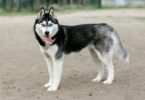Did you know that hybrid dogs often require 30% more structured training than purebreds? The Rotterman, a cross between two powerful working breeds, exemplifies this need for purposeful guidance. Combining the Rottweiler’s loyalty with the Doberman’s agility, this mix offers a unique blend of traits for dedicated owners.
This guide explores what makes these hybrids stand out. Their muscular build and sharp intelligence demand specific care strategies. You’ll learn how their temperament balances protective instincts with affectionate behavior toward families.
Key topics include grooming routines for short coats and exercise plans matching their high energy levels. Nutritional needs tailored to their growth stages and health screenings for common hereditary issues are also covered. Whether you’re adopting or already own one, these insights help create a thriving environment.
By understanding their dual-breed heritage, you can address training challenges effectively. Discover how to channel their natural alertness into positive behaviors while fostering strong bonds. Let’s dive into practical solutions for raising a well-adjusted companion.
Introduction to This Unique Hybrid
Combining two iconic working breeds creates a companion with unmatched potential. This crossbreed merges the Doberman Pinscher's sleek athleticism with steadfast devotion from its other parent. Owners gain a vigilant partner adaptable to various roles, from family guardian to agility competitor.
What Sets This Crossbreed Apart
These dogs inherit razor-sharp alertness and natural confidence. Their lineage demands purposeful engagement – bored hybrids may invent undesirable “jobs” like excessive barking. Structured routines channel their intelligence into positive behaviors.
Key traits include weather-resistant coats and muscular frames requiring regular activity. Early socialization proves critical for managing protective instincts. Puzzle toys and scent games provide essential mental challenges.
An Overview of the Ultimate Guide
This resource details three pillars of responsible ownership: customized nutrition plans, preventive healthcare, and reward-based training. You'll find strategies for leash manners and creating safe play spaces.
Families discover methods to integrate the dog into household rhythms. The guide emphasizes consistency, helping prevent common behavioral issues through proactive management. Expert insights address every life stage from adolescence to senior years.
Origins and Historical Background
What shaped the legacy of these formidable working dogs? The answer lies in their distinct yet complementary histories. Both parent breeds were forged through centuries of selective breeding for specific tasks, creating a foundation for their modern hybrid.
The Lineages of Doberman Pinscher and Rottweiler
The Doberman Pinscher traces back to 1890s Germany. Tax collector Louis Dobermann sought a loyal guardian for dangerous routes. His creation combined traits from breeds like the German Pinscher and Weimaraner.
Rottweilers boast Roman Empire roots. They drove cattle through Germany, later becoming butcher's companions. Their strength made them ideal for pulling carts and protecting earnings.
The Emergence of the Hybrid Breed
Breeders began crossing these guardians in the late 20th century. The goal? Combine the Doberman's alertness with the Rottweiler's resilience. Early mixes gained popularity among homeowners wanting versatile protectors.
Key milestones include standardized breeding practices in the 1990s. Responsible programs focused on health testing and temperament. Today, this crossbreed thrives in roles from service work to active family companionship.
Distinct Physical Characteristics
Understanding a hybrid's physique helps owners tailor their care approach effectively. These dogs showcase a balanced combination of traits from both parent lineages, requiring specific maintenance strategies. Recognizing these features ensures proper health management and informed adoption decisions.
Size, Build, and Proportions
Mature adults typically stand 24-28 inches tall, weighing 70-110 pounds. Their rectangular frame features a deep chest and robust limbs, ideal for endurance activities. Muscle definition remains prominent, reflecting working-dog heritage.
Coat, Colors, and Markings
Short, dense fur requires weekly brushing to manage shedding. Common base shades include black, mahogany, or tan. Distinctive rust-colored markings often appear above the eyes, on muzzles, or along the chest.
Some inherit the Doberman's sleek texture, while others develop the Rottweiler's slightly longer guard hairs. Seasonal coat changes demand adjusted grooming routines. Regular inspections prevent skin issues common in short-haired breeds.
In-Depth Temperament and Behavior
What defines the personality of this devoted canine companion? These hybrids thrive on human connection, blending steadfast loyalty with spirited playfulness. Their protective nature requires thoughtful guidance to balance vigilance with household harmony.
Loyalty, Playfulness, and Protective Instincts
This breed forms unshakable bonds with their family. They'll shadow household members, always ready to engage in games or relax during downtime. Their watchful demeanor makes them natural guardians, though proper training ensures they distinguish threats from normal activities.
High energy levels demand consistent physical and mental challenges. Daily walks paired with interactive fetch sessions help channel their drive constructively. Puzzle feeders and obedience drills prevent boredom-related mischief while reinforcing desired behaviors.
Early socialization proves vital for nurturing confidence. Exposure to diverse environments and people during puppyhood reduces overprotectiveness. Well-socialized adults typically greet strangers politely after initial assessment, maintaining alertness without aggression.
Affection shines through their daily interactions. Many owners report their hybrid curling beside children during homework or nudging hands for morning pets. This blend of warmth and wariness creates a multifaceted companion suited for active households.
Essential Grooming and Dental Care
Proper hygiene routines prevent skin issues and costly vet visits. For active hybrids with short coats, consistent care maintains their sleek appearance and overall health. Let’s break down the key practices every owner should prioritize.
Brushing, Bathing, and Nail Maintenance
Weekly brushing removes loose hair and distributes natural oils. Use a rubber curry brush for short coats – it massages the skin while controlling shedding. Baths every 6-8 weeks with oatmeal shampoo prevent dryness, especially after muddy adventures.
Trim nails monthly to avoid cracking. If you hear clicking on floors, it’s time for a clip. Pair grooming sessions with treats to create positive associations. Many owners find expert grooming tips helpful for mastering these techniques.
Importance of Regular Dental Hygiene
Daily teeth brushing fights plaque buildup. Use a finger brush and poultry-flavored toothpaste to make the process enjoyable. Focus on outer surfaces where tartar accumulates fastest.
Vets recommend annual dental checkups and professional cleanings. Chew toys with ridges also help scrape debris between brushings. Combining home care with vet visits keeps breath fresh and prevents gum disease common in muscular breeds.
Training and Socialization Strategies
Building trust through structured routines shapes confident canine companions. For energetic hybrids, early behavioral foundations prevent future challenges. Owners must balance firm guidance with encouragement to nurture adaptability.
Early Socialization Techniques
Begin exposure to diverse environments at 8-12 weeks. Introduce various surfaces, sounds, and gentle handling. Reward calm behavior during vet visits or neighborhood walks with high-value treats.
Arrange controlled meetings with vaccinated dogs and friendly strangers. Keep interactions positive but brief. Rotate locations weekly – parks, pet stores, and quiet streets all offer unique learning opportunities.
Effective Obedience Training Methods
Use clicker training for clear communication. Start with basic commands like “sit” and “leave it.” Practice in short 10-minute sessions to match young attention spans. Gradually increase distractions as skills improve.
Pair verbal cues with hand signals for better retention. For leash manners, stop moving when pulling occurs. Resume walking only when the lead loosens. Consistency across family members prevents confusion.
Advanced drills like “place” commands channel high activity levels constructively. Always end sessions on success to build confidence. Certified trainers recommend combining physical exercise with mental challenges for balanced development.
Exercise and Mental Stimulation Requirements
Active hybrids thrive when their physical and cognitive needs are met daily. These energetic companions require purposeful movement paired with problem-solving tasks to stay balanced. Without proper engagement, their sharp minds may turn to destructive habits or excessive vocalization.
Daily Physical Activity Needs
Consistent exercise prevents weight gain and reduces anxiety in high-drive dogs. Aim for 60-90 minutes of activity split into morning and evening sessions. Brisk walks, jogging, or swimming build endurance while satisfying their natural curiosity.
Agility courses and fetch games challenge coordination and speed. Rotate activities weekly to maintain interest – try hiking trails or flirt pole sessions. Always watch for overheating in warm climates, providing water breaks every 20 minutes.
Interactive Games and Puzzle Toys
Mental stimulation transforms idle energy into focused problem-solving. Food-dispensing toys like Kong Wobblers or Outward Hound puzzles encourage persistence. Hide treats around the yard for scent-based scavenger hunts that tap into their tracking instincts.
Training drills double as brain workouts. Teach “find it” commands using hidden objects or practice directional cues during walks. Rotate three different puzzle types weekly to prevent habituation and keep cognitive skills sharp.
Nutrition and Feeding Guidelines
Fueling an active hybrid requires precision—their metabolism burns calories like a high-performance engine. Proper meal planning supports muscle development and sustains energy levels throughout growth phases. Tailored diets prevent common issues like joint stress while promoting lifelong vitality.
Balanced Diet and Meal Portions
High-quality proteins should dominate meals, with sources like deboned chicken or salmon constituting 40-50% of intake. Complex carbohydrates from brown rice or sweet potatoes provide sustained energy. Fiber-rich vegetables aid digestion, while omega fatty acids maintain skin and coat health.
Portion sizes depend on age and activity. Puppies need 2-3 cups daily split into meals, adjusted monthly as they grow. Adults thrive on 4-5 cups divided into two feedings. Always measure food to prevent obesity—a common concern in large breeds.
Feeding Frequency and Nutritional Ingredients
Transition diets gradually over 7-10 days to avoid stomach upset. Mix 25% new food with current meals, increasing proportions daily. Monitor weight weekly using body condition scoring—ribs should be palpable but not visible.
Prioritize foods with AAFCO certification for complete nutrition. Nutritious homemade meals can supplement commercial kibble when balanced properly. Consult your vet to adjust ratios during growth spurts or health changes, ensuring optimal care for your companion.
Health Concerns and Preventive Measures
Proactive care helps these hybrids maintain their vigor through every life stage. While generally robust, their genetic background requires awareness of specific vulnerabilities. Regular monitoring and preventive actions significantly reduce long-term risks.
Common Health Issues to Monitor
Joint dysplasia ranks among the most frequent concerns. This condition causes irregular hip or elbow development, leading to mobility challenges. Maintaining lean weight through portion control minimizes joint stress.
Bloat (gastric torsion) poses urgent risks for deep-chested dogs. Symptoms include restlessness and unproductive vomiting. Feeding smaller meals and avoiding vigorous activity after eating helps prevent this emergency.
Cardiac issues and thyroid imbalances may emerge in adulthood. Annual screenings detect abnormalities early. Owners should watch for coughing, lethargy, or sudden weight changes as potential warning signs.
Vet Check-Ups and Preventive Care
Bi-annual veterinary exams catch developing issues before symptoms appear. Puppies need three visits in their first year for vaccinations and growth assessments. Adults benefit from blood panels checking organ function and nutrient levels.
Preventive strategies include:
1. Scheduling echocardiograms starting at age 3
2. Providing joint supplements for at-risk dogs
3. Keeping emergency vet contacts accessible
Dental cleanings every 12-18 months prevent periodontal disease. Many clinics offer wellness plans that bundle essential services at reduced costs. Consistent care ensures your companion enjoys more active years by your side.
Care and Handling of a rottweiler mix doberman puppy
Caring for a hybrid with working-dog lineage demands more than basic pet ownership. These intelligent companions thrive when owners address their physical stamina and mental sharpness through tailored routines. Proper management prevents behavioral issues while nurturing their natural abilities.
Understanding the Specific Needs of the Mix
Daily exercise must combine physical challenges with cognitive tasks. Structured walks paired with obedience drills satisfy their need for purposeful activity. Puzzle feeders that dispense treats during meals turn feeding time into brain games.
Training requires consistency and positive reinforcement. Short, engaging sessions work best to maintain focus. Redirect natural guarding instincts into commands like “watch” or “leave it” to promote controlled responses.
Grooming routines differ from many breeds due to their short, dense coat. Weekly brushing removes loose hair efficiently. Use a rubber mitt to massage skin and distribute oils during shedding seasons.
Understanding temperament is key to handling. Socialization should begin early to balance protective tendencies with friendliness. Introduce new people and animals gradually, rewarding calm interactions with praise.
New owners benefit from these strategies:
– Schedule exercise in two daily sessions to prevent restlessness
– Rotate puzzle toys weekly to sustain mental engagement
– Conduct monthly nail trims paired with dental checks
– Establish clear boundaries using visual cues and vocal tones
Veterinary partnerships ensure preventive care aligns with their energetic lifestyle. Regular check-ups catch breed-specific concerns early, letting you adjust care as needed.
Integrating the Dog into Family Life
How do active households create harmony with powerful canine companions? Establishing routines and safe spaces helps these energetic hybrids thrive alongside children and adults. Families benefit from intentional setups that channel natural enthusiasm into positive interactions.
Adapting Home Environments for Large, Energetic Dogs
Secure outdoor areas with six-foot fencing to prevent escapes during play. Indoors, designate a quiet retreat with a raised bed away from high-traffic zones. Use baby gates to manage access to fragile items while allowing visual contact.
Families with young children should establish clear boundaries. Teach kids to approach calmly and avoid disturbing the dog during meals. Interactive toys like treat-dispensing balls keep minds engaged during indoor downtime.
Daily structured playtimes prevent destructive behaviors. Combine fetch sessions with obedience drills in the backyard. Rotate chew toys weekly to satisfy natural urges while protecting furniture.
Consistent care routines build trust. Schedule feeding, walks, and training at fixed times each day. Involve all family members in responsibilities to reinforce the dog’s role as a valued companion.
Comparing Doberman and Rottweiler Traits
Understanding the distinct qualities of parent breeds reveals why their hybrid excels in specific roles. The Doberman Pinscher and Rottweiler each bring unique strengths to their offspring, shaping both appearance and behavior.
Key Differences in Characteristics
Dobermans showcase a leaner build with angular features, while Rottweilers display broader frames and heavier bone structure. Ear shapes differ significantly – Dobermans often have cropped upright ears, whereas Rottweilers naturally sport triangular folded ones.
Behavioral contrasts emerge in their working styles. Dobermans excel at rapid response tasks, thriving in agility-based roles. Rottweilers demonstrate steadier focus, making them natural guardians during prolonged assignments.
Training approaches vary between these breeds. The Doberman's high energy responds best to short, dynamic sessions. Rottweilers require consistent reinforcement to maintain engagement, benefiting from reward-based methods that build trust.
Life expectancy differs slightly, with Dobermans averaging 10-12 years and Rottweilers 8-10 years. Both breeds need regular cardiac screenings, but Rottweilers require additional hip evaluations due to their heavier build.
Care routines reflect these differences. Dobermans need more frequent coat brushing during seasonal changes. Rottweilers demand joint supplements earlier in life to support their robust frame. Hybrids inherit a blend of these needs, requiring tailored health strategies.
Final Reflections on a Lifetime of Canine Companionship
Embracing a hybrid companion brings both joy and responsibility that lasts a lifetime. Owners who commit to their unique needs gain a loyal family member with remarkable protective instincts. Through consistent training and proper care, these dogs thrive in active households for years.
Maintaining well-being requires vigilance against common health concerns like joint issues and bloat. Regular vet check-ups and balanced nutrition form the foundation of longevity. Pairing physical activities with mental stimulation keeps their sharp minds engaged and bodies strong.
Safety measures like secure fencing and structured routines prevent accidents. Early socialization ensures positive interactions with children and guests. Their activity level demands daily challenges, from puzzle toys to agility exercises.
Investing time in understanding their Doberman Pinscher heritage pays off in trust and companionship. While challenges arise, the rewards of a well-adjusted protector enrich family life for over a decade. With dedication, owners forge bonds that withstand the test of time.
FAQ
What health issues should owners watch for in this hybrid breed?
Common health concerns include hip dysplasia, bloat, and heart conditions inherited from parent breeds. Regular vet check-ups, joint supplements, and controlled feeding routines help manage risks. Early detection through screenings improves long-term outcomes.
How challenging is training a Rottweiler-Doberman mix?
These intelligent dogs respond well to consistent, reward-based training but may exhibit stubbornness. Start socialization early to curb territorial tendencies. Structured obedience classes and mental challenges like scent work enhance cooperation.
What grooming routine works best for their coat type?
Weekly brushing with a slicker brush manages moderate shedding. Bathing every 6–8 weeks using hypoallergenic shampoo prevents skin irritation. Pay attention to nail trimming and ear cleaning to avoid infections.










Leave a Comment